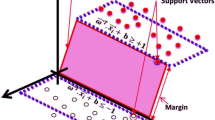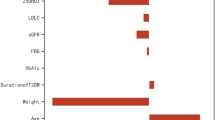Abstract
Chronic kidney disease (CKD) is a continuing loss of kidney function, and early detection of this disease is fundamental to halting its progression to end-stage disease. Numerous methods have been proposed to detect CKD, mainly focusing on classification based upon peripheral clinical parameters and quantitative ultrasound parameters that must be manually calculated, or on shear wave elastography. No studies have been found that detect the presence or absence of CKD based solely from one B-mode ultrasound image. In this work, we propose an automated system to detect chronic kidney disease utilizing only the automatic extraction of features from a B-mode ultrasound image of the kidney, with a database of 405 images. Higher-order bispectrum and cumulants, and elongated quinary patterns, are extracted from each image to provide a final total of 24,480 features per image. These features were subjected to a locality sensitive discriminant analysis (LSDA) technique, which provides 30 LSDA coefficients. The coefficients were arranged according to their t value and inserted into various classifiers, to yield the best diagnostic accuracy using the least number of features. The best performance was obtained using a support vector machine and a radial basis function, utilizing only five features, resulting in an accuracy of 99.75%, a sensitivity of 100%, and a specificity of 99.57%. Based upon these findings, it is evident that the technique accurately and automatically identifies subjects with and without CKD from B-mode ultrasound images.




Similar content being viewed by others
References
Webster AC, Nagler EV, Morton RL, Masson P (2017) Chronic kidney disease. Lancet 389(10075):1238–1252
Clinical Practice Guidelines-Management of chronic kidney disease in adults (2011). www.acadmed.org.my/view_file.cfm?fileid=497. Accessed 16 Jan 2019
Remer EM, Papanicolaou N, Casalino DD, Bishoff JT, Blaufox MD, Coursey CA, Dighe M, Eberhardt SC, Goldfarb S, Harvin HJ, Heilbrun ME, Leyendecker JR, Nikolaidis P, Oto A, Preminger GM, Raman SS, Sheth S, Vikram R, Weinfeld RM (2014) ACR appropriateness criteria® on renal failure. Am J Med 127(11):1041–1048.e1
Fiorini F, Barozzi L (2007) The role of ultrasonography in the study of medical nephropathy. J Ultrasound 10(4):161–167
Norouzi J, Yadollahpour A, Mirbagheri SA, Mazdeh MM, Hosseini SA (2016) Predicting renal failure progression in chronic kidney disease using integrated intelligent fuzzy expert system. Comput Math Methods Med 2016:1–9
Gao J, Perlman A, Kalache S, Seshan S, Smith L, Chevalier J (2017) Multiparametric quantitative ultrasound imaging to assess chronic kidney disease. Ultrasound Med Biol 43:S209
Leong SS, Wong JHD, Md Shah MN, Vijayananthan A, Jalalonmuhali M, Ng KH (2018) Shear wave elastography in the evaluation of renal parenchymal stiffness in patients with chronic kidney disease. Br J Radiol 91:20180235
Samir AE, Allegretti AS, Zhu Q, Dhyani M, Anvari A, Sullivan DA, Trottier CA, Dougherty S, Williams WW, Babitt JL, Wenger J, Thadhani RI, Lin HY (2015) Shear wave elastography in chronic kidney disease: a pilot experience in native kidneys. BMC Nephrol 16(1):119
Pizer SM, Amburn EP, Austin JD, Cromartie R, Geselowitz A, Greer T, ter Romeny Haar B, Zimmerman JB, Zuiderveld K (1987) Adaptive histogram equalization and its variations. Comput Vis Graph Image Process 39(3):355–368
Radon J (1986) On the determination of functions from their integral values along certain manifolds. IEEE Trans Med Imaging 5(4):170–176
Nikias CL, Raghuveer MR (1987) Bispectrum estimation: a digital signal processing framework. Proc IEEE 75(7):869–891
Martis RJ, Acharya UR, Mandana KM, Ray AK, Chakraborty C (2013) Cardiac decision making using higher order spectra. Biomed Signal Process Control 8(2):193–203
Martis RJ, Acharya UR, Lim CM, Mandana KM, Ray AK, Chakraborty C (2013) Application of higher order cumulant features for cardiac health diagnosis using ECG signals. Int J Neural Syst 23(04):1350014
Al-Sumaidaee SAM, Abdullah MAM, Al-Nima RRO, Dlay SS, Chambers JA (2017) Multi-gradient features and elongated quinary pattern encoding for image-based facial expression recognition. Pattern Recognit 71:249–263
Raghavendra U, Gudigar A, Maithri M, Gertych A, Meiburger KM, Yeong CH, Madla C, Kongmebhol P, Molinari F, Ng KH, Acharya UR (2018) Optimized multi-level elongated quinary patterns for the assessment of thyroid nodules in ultrasound images. Comput Biol Med 95:55–62
Chen Weiting, Wang Zhizhong, Xie Hongbo, Wangxin Yu (2007) Characterization of surface EMG signal based on fuzzy entropy. IEEE Trans Neural Syst Rehabilit Eng 15(2):266–272
Kapur JN, Sahoo PK, Wong AKC (1985) A new method for gray-level picture thresholding using the entropy of the histogram. Comput Vis Graph Image Process 29(3):273–285
Renyi A (1961) On measures of entropy and information. In: Fourth Berkeley symposium on mathematical statistics and probability, volume 1: contributions to the theory of statistics 547–561
Shannon CE (2001) A mathematical theory of communication. ACM SIGMOBILE Mob Comput Commun Rev 5(1):3–55
Pandey V, Gupta V (2014) MRI image segmentation using Shannon and non Shannon entropy measures. Int J Appl Innov Eng Manag 3(7):41–46
Hu Q, Yu D (2004) Entropies of fuzzy indiscernibility relation and its operations. Int J Uncertain Fuzziness Knowl Based Syst 12(05):575–589
Cai D, He X, Zhou K, Han J, Bao H (2007) Locality sensitive discriminant analysis. In: 20th international joint conference on artificial intelligence, pp 708–713
Acharya UR, Raghavendra U, Fujita H, Hagiwara Y, Koh JE, Jen Hong T, Sudarshan VK, Vijayananthan A, Yeong CH, Gudigar A, Ng KH (2016) Automated characterization of fatty liver disease and cirrhosis using curvelet transform and entropy features extracted from ultrasound images. Comput Biol Med 79:250–258
Duda R, Hart P, Stork D (2012) Pattern classification. Wiley, Hoboken
Pławiak P (2018) Novel genetic ensembles of classifiers applied to myocardium dysfunction recognition based on ECG signals. Swarm Evolut Comput 39:192–208
Pławiak P, Rzecki K (2015) Approximation of phenol concentration using computational intelligence methods based on signals from the metal-oxide sensor array. IEEE Sens 15(3):1770–1783
Parikh R, Mathai A, Parikh S, Sekhar GC, Thomas R (2008) Understanding and using sensitivity, specificity and predictive values. Indian J Ophthalmol 56(1):45–50
Luis-Lima S, Porrini E (2017) An overview of errors and flaws of estimated GFR versus true GFR in patients with diabetes mellitus. Nephron 136(4):287–291
Wood AJ, Churilov L, Perera N, Thomas D, Poon A, MacIsaac RJ, Jerums G, Ekinci EI (2016) Estimating glomerular filtration rate: performance of the CKD-EPI equation over time in patients with type 2 diabetes. J Diabetes Complicat 30(1):49–54
Rossing P, Rossing K, Gaede P, Pedersen O, Parving H-H (2006) Monitoring kidney function in type 2 diabetic patients with incipient and overt diabetic nephropathy. Diabetes Care 29(5):1024–1030
Fontseré N, Salinas I, Bonal J, Bayés B, Riba J, Torres F, Rios J, Sanmartí A, Romero R (2006) Are prediction equations for glomerular filtration rate useful for the long-term monitoring of type 2 diabetic patients? Nephrol Dial Transplant 21(8):2152–2158
Zamir G, Sakran W, Horowitz Y, Koren A, Miron D (2004) Urinary tract infection: Is there a need for routine renal ultrasonography? Arch Dis Child 89(5):466–468
Lee H, Hyun Soh B, Hee Hong C, Joon Kim M, Won Han S (2009) The efficacy of ultrasound and dimercaptosuccinic acid scan in predicting vesicoureteral reflux in children below the age of 2 years with their first febrile urinary tract infection. Pediatr Nephrol 24(10):2009–2013
Kunwar V, Chandel K, Sabitha AS, Bansal A (2016) Chronic kidney disease analysis using data mining classification techniques. In 2016 6th international conference: cloud system and big data engineering (Confluence), pp 300–305
Jena L, Kamila NK (2015) Distributed data mining classification algorithms for prediction of chronic-kidney-disease. Int J Emerg Res Manag Technol 11:2278–9359
Vijayarani S, Dhayanand MS (2015) Kidney disease prediction using SVM and ANN algorithms. Int J Comput Bus Res 6(2):2229–6166
Sinha P, Sinha P (2015) Comparative study of chronic kidney disease prediction using KNN and SVM. Int J Eng Res Technol 4(12):608–612
Faust O, Hagiwara Y, Tan JH, Oh SL, Acharya UR (2018) Deep learning for healthcare applications based on physiological signals: a review. Comput Methods Programs Biomed 161:1–13
Krizhevsky A, Sutskever I, Hinton GE (2012) ImageNet classification with deep convolutional neural networks. In: Proceedings of the 25th international conference on neural information processing systems, vol 1, Lake Tahoe, Nevada, pp 1097–1105
Rafiei MH, Adeli H (2017) A novel machine learning based algorithm to detect damage in highrise building structures. Struct Des Tall Special Build. https://doi.org/10.1002/tal.1400
Tan JH, Bhandary SV, Sivaprasad S, Hagiwara Y, Bagchi A, Raghavendra U, Rao AK, Raju B, Shetty NS, Gertych A, Chua KC, Acharya UR (2018) Age-related macular degeneration detection using deep convolutional neural network. Future Gener Comput Syst 87:127–135
Lee JG, Jun S, Cho YW, Lee H, Kim GB, Seo JB, Kim N (2017) Deep learning in medical imaging: general overview. Korean J Radiol 18(4):570–584
Raghavendra U, Bhat NS, Gudigar A, Acharya UR (2018) Automated system for the detection of thoracolumbar fractures using a CNN architecture. Future Gener Comput Syst 85:184–189
Acharya UR, Fujita H, Oh SL, Hagiwara Y, Tan JH, Adam M, Tan RS (2018) Deep convolutional neural network for the automated diagnosis of congestive heart failure using ECG signals. Appl Intell 48:1–12
Tan JH, Hagiwara Y, Pang W, Lim I, Oh SL, Adam M, Tan RS, Chen M, Acharya UR (2018) Application of stacked convolutional and long short-term memory network for accurate identification of CAD ECG signals. Comput Biol Med 94:19–26
Acharya UR, Oh SL, Hagiwara Y, Tan JH, Adeli H, Subha DP (2018) Automated EEG-based screening of depression using deep convolutional neural network. Comput Methods Programs Biomed 161:103–113
LeCun Y, Bengio Y, Hinton G (2015) Deep learning. Nature 521:436–444
Acknowledgements
The study was supported by UMSE CA.R.E fund (PV018-2018), University of Malaya. We expressed our gratitude to Dr Maisarah Jalalonmuhali for helping in this study.
Author information
Authors and Affiliations
Corresponding author
Ethics declarations
Conflict of interest
All authors declare that they have no conflict of interest in this work.
Additional information
Publisher's Note
Springer Nature remains neutral with regard to jurisdictional claims in published maps and institutional affiliations.
Rights and permissions
About this article
Cite this article
Acharya, U.R., Meiburger, K.M., Koh, J.E.W. et al. Automated detection of chronic kidney disease using higher-order features and elongated quinary patterns from B-mode ultrasound images. Neural Comput & Applic 32, 11163–11172 (2020). https://doi.org/10.1007/s00521-019-04025-y
Received:
Accepted:
Published:
Issue Date:
DOI: https://doi.org/10.1007/s00521-019-04025-y




